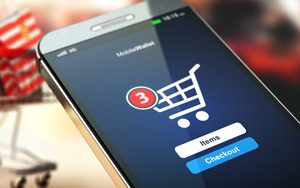 by Kayla Matthews
by Kayla Matthews
The design of your checkout process can significantly impact how many customers make it through the sales funnel. Even subtle design decisions that make checkout slightly less convenient — like surprise fees, overly long forms and required account creation — can result in higher cart abandonment.
That’s especially true toward the holiday season, when customers are hurrying to finish gift shopping and your business is competing with deals and offers from hundreds of other sites. Fortunately, with the right design, it’s possible to streamline your checkout process so more customers make it through checkout. Below are three exemplary ecommerce sites that use subtle design features to streamline that checkout process and encourage conversions.
1. Segmenting the Checkout Form
Ecommerce businesses need a significant amount of customer information to complete a purchase. As a result, many checkout forms are long, including fields for address, billing details and shipping methods. According to data from Baymard, a lengthy checkout process is one of the leading reasons for cart abandonment. Simplifying the checkout process and limiting the apparent size of a lead form can help prevent these forms from becoming overwhelming.
[ASOS]
For an example of how you can manage long forms, look at the accordion-style checkout from ASOS’ online storefront. As the customer proceeds, the form expands, showing them only the fields they need to fill out, plus what they’ve already completed. The accordion-style checkout is an ideal way to make complicated forms easier to parse visually, without splitting the form across pages — which can result in increased loading, potentially causing more cart abandonment.
2. Secure Cross-Sells
You can also use design immediately before the checkout process to secure the sales of some additional products. Well-placed, relevant and valuable recommendations are often successful ways to get customers to add extra items to their cart. For an example of this in practice, see how Ikea’s website responds when a user puts a high-value item in their cart.
[IKEA]
Upon clicking the “add to shopping bag” button, a sidebar with eight product recommendations appears. Each of these has a button that allows users to quickly add the product to their online shopping bag. All the recommendations relate to the original thing the customer added to their shopping bag — in this case, a sofa.
While Ikea doesn’t try to upsell the customer in this example, you can use similar design elements for that purpose. Does your business offer products that come with warranties, add-ons or advanced features? In that case, a pop-in sidebar listing available upgrades can be a subtle way to encourage customers to spend more.
Ecommerce businesses can lose potential sales by not offering valuable and relevant recommendations. That’s especially true if you’re offering seasonal items consumers may not have noticed otherwise.
3. Offer a Guest Checkout Option
Most ecommerce sites ask customers to register or sign in when checking out. Having a customer logged in benefits the shopper and the business. Once someone logs in, the site can access information on their past orders, while providing the retailer with more details to improve the accuracy of recommendations and offers.
However, requiring a user to log in before they check out can often send the process to a screeching halt. Around 35 percent of customers abandon their carts because a website required them to create an account, according to a PYMNTS report.
Often, a customer may not know their username or password, and the idea of hunting for that info may encourage them to abandon their cart. The prompt to log in may also catch them off-guard, leading to a similar outcome. Seasonal events can make this tendency even more noticeable — like during the holidays, when customers may be in a rush to wrap up their shopping.
You can avoid this pitfall by making it easy to checkout without logging on, while also providing the opportunity to do so. For an excellent example of how you can provide both options, consider the checkout for Uniqlo, the Japanese casual-wear brand.
[uniqlo]
The page users see when they click “check out” is doing a few different things. First, it makes it extremely clear that a customer can finish shopping without logging in. It also makes it easy for customers to preselect their payment method, speeding things up if they want to use PayPal. The page also includes the option to log in and shows what a customer can get if they choose to create an account — in this case, free shipping on their first order.
How Results-Driven Design Can Improve Your Site’s Checkout
Simple adjustments to your site’s checkout process can help maximize conversions and cut down on cart abandonment. Design tweaks that streamline purchases — like guest checkout and accordion-style checkout design — can make a significant difference. You can also use the checkout process to upsell or cross-sell products to your customers, potentially boosting sales.
